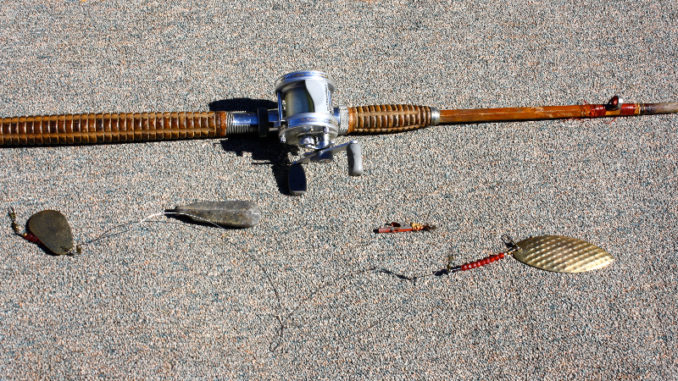
Use a discarded rod and reel, add a few components and get that bait down deep
With striped bass, hybrid bass, spotted bass and white bass in many North Carolina lakes, downriggers have become standard equipment to get baits down to these open-water fish, but they aren’t a poor-man’s fishing tool, with most systems costing more than $200. To fish deep without going into debt, consider a do-it-yourself downrigger that can be assembled in about 20 minutes with materials likely at hand.
You’ll need a heavy trolling or baitcasting rod, preferably one that’s been broken, and an old reel, a 22-inch lake troll, 8-ounce or heavier bank or pyramid sinker, a No. 5 snap, a No. 5 snap swivel, an alligator clip, a garment hook and eye and small-gauge electrical wire.
Only the butt and handle section of the rod, plus the first guide ring, are needed. Saw off the rest. Mount a level-wind or baitcasting reel and fill it with 20-pound or heavier monofilament. This gives you the boom of your downrigger. Stretch out a 22-inch or longer lake troll and remove any hooks, keeping the hardware intact. Fashion a 2-foot leader using the monofilament, tying one end to the front of the troll and the free end to a No. 5 snap using an improved clinch knot. Add the weight to the midpoint of the leader using a dropper loop.
Join the line-housing assembly to the weight and attractor by tying the line from the mounted reel after threading it through the lone line guide to the leader snap on the front of your lake troll. Connecting clip and line release. Take a 2-foot piece of 10-pound monofilament and tie one end to the rear of the lake troll. At the other end of the line, form a dropper loop. Push the loop through the sleeve of the alligator clip, then bring the loop up and over the jaws of the clip and tighten.
Select an appropriate fishing outfit for the species you’re after. Rig your rod and reel as usual, but don’t tie on your lure.
Get a hook and eye garment clasp; keep the hook partly only. Strip the insulation from a 4-inch piece of small gauge electrical wire and tightly wrap or solder the wire around the bend of the garment hook, letting about a ¼-inch of the wire protrude from the hook. Push the end of the line of your fishing outfit through one of the metal loops of the hook so the loop slides freely up and down the line. Tie a No. 5 snap swivel to the end of your line to keep the hook from sliding off. Using the same pound test spooled on your fishing outfit, tie a 2-foot leader to the snap swivel and attach your lure to the end of the leader.
When you’re ready to fish, shortened rod in a rod holder and place your fishing outfit in a nearby rod holder. Grab the alligator clip of your downrigger and clip it to the wire protruding from the garment hook on your line. Your downrigger is now connected to the fishing line of your outfit.
Troll slowly. Pay out line gradually from the “downrigger” reel as you simultaneously pay out line from your fishing reel until you reach the desired depth. When a fish strikes, the force of the strike will yank the alligator clip free from the wired garment hook. You’ll play the fish without the weight of the downrigger.
One tip is to wrap a rubber band several times around the jaws of the alligator clip should the clip pull free from the wired garment hook because of water pressure. Attach standard crappie bobbers to the lake troll for buoyancy.



Be the first to comment